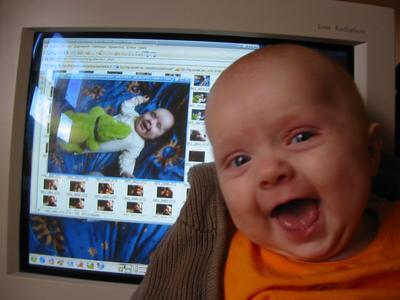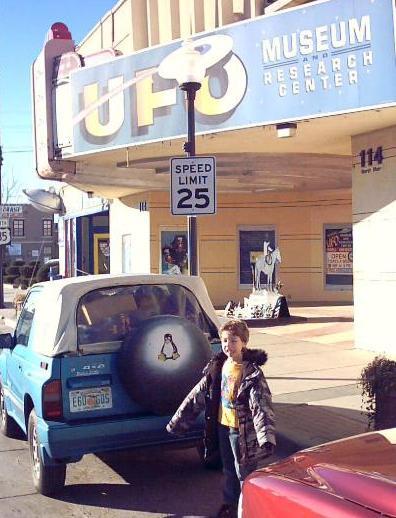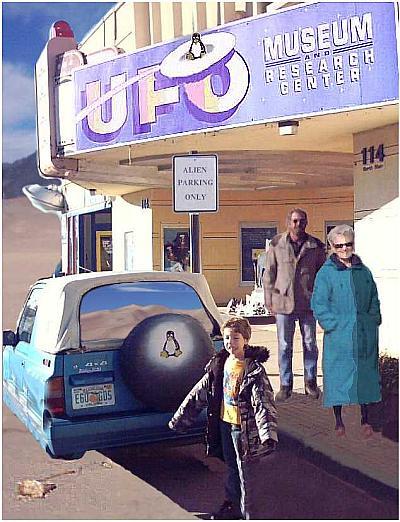

My baby daughter who is only 3.5 months old just loves Linux. After installing SuSE on my new and shiny P4 and introducing her to Geeko the chameleon, she is getting very interested. She especially likes KDE. I guess she is attracted by the Fisher Price Toys-like look and feel of the Keramik theme. The photo shows Idun showing her enthusiasm for KDE.
How many Linux users have children already Linux-enabled? Are babies welcome at Linux Counter?

In the January 2004 issue of Linux Journal, I came across the article
on SMART by Bruce Allen on page 74. I downloaded and installed it without a hitch.
I ran it with the -t (test) option and immediately afterward I
encountered disk errors. (Before I ran smartctl everything was
fine.) I shut down and rebooted. The system ran fsck because it
encountered errors on the hard drive. I eventually had to run fsck
in manual mode and lost info.
—
Marshall Lake
Bruce Allen replies: I'm sorry to hear you've had disk problems. What's happened in your case is unfortunate. You had a disk that already was compromised before you examined the SMART data and ran self tests. Probably some of the disk sectors were unreadable, but you didn't know it because they were storing files that you normally don't access. When you ran a disk self test using smartctl -t, this did a read-scan of the disk, and the disk problems became apparent.
Before investing additional time in the system with this disk, make sure that the disk does pass a long self test without errors and that the Current pending sector and/or Offline pending sector raw counts are zero. If not, the disk needs repair/replacement before you fix the OS problems.
If your OS distribution is RPM-based, I suggest that you use the verify options of RPM to make a list of all missing or changed files on your system along with the name of the package that they came from. Then, re-install the packages that have missing or corrupted files.
The failure rate of new hardware (and particularly new disks) is higher than when they are a few days or weeks old. New hardware is more likely to fail than hardware that has worked for some time. The fact that fsck worked okay means only that the filesystem is consistent. It does not read all the data from the disk.
The smartctl -t command starts a self test that reads every byte on the disk. This is a much more thorough test than fsck. I strongly advise you not to trust the disk unless it runs a smartctl -t long test without revealing any problems.
I just read your I/O scheduler article in the February 2004
Linux Journal. Great article, but it left me with a few questions.
Hopefully you can answer them for me. How do the Deadline and
Anticipatory I/O Schedulers detect when a deadline has been met
or passed? Are there multiple kernel threads, one or more that
are processing the main queue and one or more that are walking the
read/write queues checking deadlines? Wouldn't the Anticipatory
algorithm also give the possibility of causing starvation? If we
assume a request comes in and the deadline passes, the I/O scheduler
will see that the deadline is passed and process the request, then
wait 6 milliseconds thinking there may be one or more requests in the
same area. If there are one or more requests in the same area, then
will it basically loop processing these close requests, waiting
6 milliseconds, processing more requests, etc.? The test outputs
really show how much better the I/O schedulers in 2.6 are than in 2.4
, but how much does the process scheduler play into this—choosing the O(1) scheduler over the default 2.4 scheduler?
—
Torin Ford
Robert Love replies: Glad you liked the article. There are no threads involved. The I/O scheduler code is handled in two places: in the interrupt handler for the disk's driver and in the process context code of the process submitting the request. The code can detect a deadline easily, because the deadline-sorted lists are inherently FIFO. The request at the head of the list has the oldest expiration, so the list need not be walked—just peek at the head of the FIFO list.
In reply to the question about whether the anticipatory algorithm will also lead to starvation, eventually another request will expire, and it will go service it. The anticipation heuristic is just used to decide where to seek to, it otherwise does not change the algorithm of the disk.
I don't think the better process scheduler comes into play whatsoever. We know why the times are better: the writes-starving-reads phenomenon, so the better numbers are readily explainable.
The February 2004 issue of Linux Journal once again has the awful phrase
“comprised of” (on page 56). Can I ask you to grep through incoming
manuscripts to catch this annoying solecism in the future?
—
A. T. Young
It'll be in our stylebook from now on. —Ed.
I was on a Virgin plane in December 2003 with such a faulty system
that something like 90% of us mostly saw the reboot console! Luckily,
it was a night flight, otherwise the kids would have gone crazy, and
there was no mention of Linux on the screen, so most people would
not have associated it with our beloved OS! However, it also shows
that we need to release only well-tested stuff to real customers,
a lesson we need to learn if Linux is to move into the home
environment.
—
Kirk Martinez
University of Southampton
Recently I went looking for a Linux compatability list
on the Web and I was unable to locate one. Does LJ
know where one is located?
—
Walt L. Williams
Every major Linux distribution maintains a hardware compatibility list. Not all distributions include the same hardware support, so you need to check yours. If you want to know whether there's a driver available in source code form that you can compile and configure, you usually can do best by searching for the hardware name +linux on Google. —Ed.
I noticed a mistake in the February 2004 issue of LJ in the article by myself and Luciano Barone about REDACLE. In the text there is a reference to Table 2 that is missing. Table 2 should, in fact, read as follows:
Only the first row is relevant for text comprehension. Tables
actually marked as 2 through 6 should be renamed 3 to 7.
—
Giovanni Organtini
Here are a couple of photos of our last vacation. We went to Roswell, New Mexico to find out if the aliens were using Linux. Most were Debian supporters. There is a before and after photo. Some help from The GIMP was required.


Photo of the month gets you a one-year subscription. Send to info@linuxjournal.com. —Ed.
After reading Steve Hastings' review of Lindows 4.0 [LJ, December 2003], I had a few comments of my own to add. First, concerning the Click-n-Run warehouse, I had many of the same complaints as Steve. Along with the rebranding of many packages and the inability to get packages to work properly, there is a serious problem with software versions being behind the curve. For instance, their OpenOffice.org version is 1.0.3, whereas the current OpenOffice.org is 1.1.x. Evolution in the warehouse is on version 1.2, while Ximian is on version 1.4. There are many examples of this.
Another serious problem is in the area of customer support. I sent a report to Lindows tech support in late December 2003 about these issues and have yet to receive anything other than an automated response (“We'll reply to this issue in a few days”). Since that initial report, I've sent two follow-ups, and those have gone unanswered as well.
Having said all that, I will agree that Lindows is very simple to install. I tried both 4.0 and the new 4.5 version, and they install in less than 15 minutes. There were problems with the video card (an ATI All-in-Wonder) and the media-card reader, but I have less problems with getting Lindows to work with the hardware than I did with Mandrake, Red Hat and that other company from Redmond.
But, until they have current version applications available in the
Click-n-Run warehouse and until they resolve the issues with customer
support, I won't be recommending Lindows to anyone.
—
Ed Dulaney
The Linux magazines have been conspicuously quiet about two of the
biggest Linux stories of 2003. The first is Red Hat rolling their
Linux into Fedora Core and dropping support of their older versions.
The second is Novell buying SuSE and Ximian.
Red Hat is putting a positive spin on their story, while many
others believe it's a blunder on Red Hat's part and a betrayal of
their customers.
Novell, is now a major Linux player. Does it all of a sudden
have Linux religion? Will they contribute to Linux's evolution?
Or is Linux just the latest strategy/weapon in their age-old war
with Microsoft?
Both these stories have a big impact on the Linux community,
and they are getting a lot of coverage and discussion on-line.
I would expect LJ to join in on the same. Will this happen soon?
—
Henry E. Alubowicz
See the next letter for why these stories might be less important than you think. —Ed.
Just wanted to commend Doc on a great piece (“DIY-IT...” [LJ, February 2004]) and LJ for being a brave enough to print it, despite its vendor-specific (read: advertiser) implications.
Doc is on to the scoop of his journalistic career with his series on how open source (and LAMP in particular) is taking over the enterprise and putting customers back in control. The game is no longer about getting spoon-fed solutions that take too long to implement, cost too much money and fail to address the specific needs of any given business. It's time to say good-bye to cookie-cutter enterprise software and Doc knows it.
What is more, another reason why he is on to something big is because the open-source way, and the LAMP platform in particular, make developers more productive. Vendors know it, developers who have used the tools know it, and even those that haven't are beginning to suspect it.
In my day-to-day, I deal with friends and colleagues (as well as my own staff) whose employers everyone would recognize as being pillars of the Internet economy. These folks depend daily on the huge productivity improvements that come from open development tools and the passionate communities willing to stand behind them. However, most of them either won't, or can't for various corporate reasons, climb the nearest tree and scream to the world about it.
Like dark matter that can't be seen but whose presence is felt
everywhere, all of these folks “in the know” are rebuilding the
very infrastructure on which IT depends, one brick at a time. And, in
perhaps what is just as important, they are also rebuilding all
of the starting assumptions behind what “enterprise
software”
is all about.
So thanks Doc and LJ. Keep on it—you're on to
something big.
—
Antonio Rodriguez
VP Engineering
In the article “DIY-IT: How Linux and Open Source Are Bringing Do-It-Yourself to Information Technology” [LJ, February 2004], Craig McLane, VP of Technology at Ticketmaster, was mistakenly identified as the source of quotations that were in fact made by Sean Moriarty, EVP of Products and Technology at Ticketmaster. The article also said the event where the talk took place was LinuxWorld Expo. In fact, both men spoke at the O'Reilly Open Source Convention. —Doc Searls